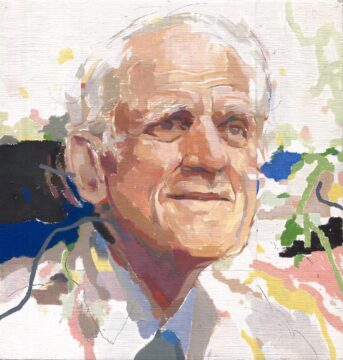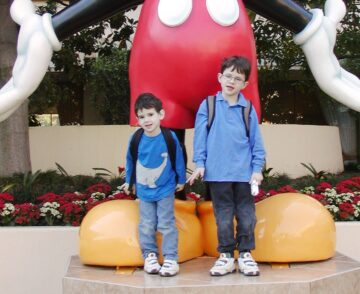Shelly Fan in Singularity Hub:
 Compared to other primates, our brains are exceptionally large. Why?
Compared to other primates, our brains are exceptionally large. Why?
A new study comparing neurons from different primates pinpointed several genetic changes unique to humans that buffer our brains’ ability to handle everyday wear and tear. Dubbed “evolved neuroprotection,” the findings paint a picture of how our large brains gained their size, wiring patterns, and computational efficiency. It’s not just about looking into the past. The results could also inspire new ideas to tackle schizophrenia, Parkinson’s disease, and addiction caused by the gradual erosion of one type of brain cell. Understanding these wirings may also spur artificial brains that learn like ours. The results haven’t yet been reviewed by other scientists. But to Andre Sousa at the University of Wisconsin-Madison, who wasn’t involved in the work, the findings can help us understand “human brain evolution and all the potentially negative and positive things that come with it.”
More here.
Enjoying the content on 3QD? Help keep us going by donating now.


 Progress used to be glamorous. For the first two thirds of the twentieth-century, the terms modern, future, and world of tomorrow shimmered with promise. Glamour is more than a synonym for fashion or celebrity, although these things can certainly be glamorous. So can a holiday resort, a city, or a career. The military can be glamorous, as can technology, science, or the religious life. It all depends on the audience. Glamour is a form of communication that, like humor, we recognize by its characteristic effect. Something is glamorous when it inspires a sense of projection and longing: if only . . .
Progress used to be glamorous. For the first two thirds of the twentieth-century, the terms modern, future, and world of tomorrow shimmered with promise. Glamour is more than a synonym for fashion or celebrity, although these things can certainly be glamorous. So can a holiday resort, a city, or a career. The military can be glamorous, as can technology, science, or the religious life. It all depends on the audience. Glamour is a form of communication that, like humor, we recognize by its characteristic effect. Something is glamorous when it inspires a sense of projection and longing: if only . . . Lyric poets and mathematicians, by general agreement, do their best work young, while composers and conductors are evergreen, doing their best work, or more work of the same kind, as they age. Philosophers seem to be a more mixed bag: some shine early and some, like
Lyric poets and mathematicians, by general agreement, do their best work young, while composers and conductors are evergreen, doing their best work, or more work of the same kind, as they age. Philosophers seem to be a more mixed bag: some shine early and some, like  Anyway, in the video recording of The Cure performing A Forest for Dutch television in 1980 one encounters a version of The Cure that doesn’t quite jibe with later versions of the band. Robert Smith, in particular, has short spiky hair and looks nothing like the fully-coiffed gothic prince that he would soon become. He also looks annoyed or indifferent. And he has swapped instruments with Simon Gallup, the bassist for the band. Simon plays guitar in this live version. Robert Smith plucks away at the familiar bassline. Strange. Even stranger when one realizes that the strings on the bass are so slack there is no way they could be making any proper sound. And Robert Smith isn’t playing the notes correctly or in the right rhythm anyway.
Anyway, in the video recording of The Cure performing A Forest for Dutch television in 1980 one encounters a version of The Cure that doesn’t quite jibe with later versions of the band. Robert Smith, in particular, has short spiky hair and looks nothing like the fully-coiffed gothic prince that he would soon become. He also looks annoyed or indifferent. And he has swapped instruments with Simon Gallup, the bassist for the band. Simon plays guitar in this live version. Robert Smith plucks away at the familiar bassline. Strange. Even stranger when one realizes that the strings on the bass are so slack there is no way they could be making any proper sound. And Robert Smith isn’t playing the notes correctly or in the right rhythm anyway. There appear to be two types of drivers in North America these days: those who think about headlights only when one of theirs goes out, and those who fixate on them every time they drive at night. If you’re in the first camp, consider yourself lucky. Those in the second camp—aggravated by the excess glare produced in this new era of light-emitting diode headlights—are riled up enough that the National Highway Traffic Safety Administration receives more consumer complaints about headlights than any other topic, several insiders told me.
There appear to be two types of drivers in North America these days: those who think about headlights only when one of theirs goes out, and those who fixate on them every time they drive at night. If you’re in the first camp, consider yourself lucky. Those in the second camp—aggravated by the excess glare produced in this new era of light-emitting diode headlights—are riled up enough that the National Highway Traffic Safety Administration receives more consumer complaints about headlights than any other topic, several insiders told me. Noam Chomsky, one of the world’s most famous and respected intellectuals, will be 96 years old on Dec. 7, 2024. For more than half a century, multitudes of people have read his works in a variety of languages, and many people have relied on his commentaries and interviews for insights about intellectual debates and current events.
Noam Chomsky, one of the world’s most famous and respected intellectuals, will be 96 years old on Dec. 7, 2024. For more than half a century, multitudes of people have read his works in a variety of languages, and many people have relied on his commentaries and interviews for insights about intellectual debates and current events.
 Many of the innovators who are advancing science, technology and culture are those whose unique cognitive abilities were identified and supported in their early years through enrichment programmes such as Johns Hopkins University’s
Many of the innovators who are advancing science, technology and culture are those whose unique cognitive abilities were identified and supported in their early years through enrichment programmes such as Johns Hopkins University’s  Jim and Louise
Jim and Louise This book review is a Trojan horse. Ostensibly it concerns a collection of letters titled “Love, Joe,” written by the downtown
This book review is a Trojan horse. Ostensibly it concerns a collection of letters titled “Love, Joe,” written by the downtown